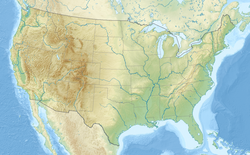The Shuttle Meadow Formation is a Mesozoic geologic formation in the Hartford Basin in Connecticut and Massachusetts, USA.[1] Insect fossils of Mormolucoides articulatus and dinosaur remains are among the fossils that have been recovered from the formation; Coelophysis sp.[2]
| Shuttle Meadow Formation | |
|---|---|
| Stratigraphic range: Hettangian ~ | |
 Talcott Formation over Shuttle Meadow Formation in a quarry (Connecticut) | |
| Type | Geological formation |
| Unit of | Newark Supergroup Meriden Group |
| Underlies | Talcott Formation |
| Lithology | |
| Primary | Black shale |
| Other | Siltstone |
| Location | |
| Coordinates | 41°24′N 72°42′W / 41.4°N 72.7°W |
| Approximate paleocoordinates | 22°06′N 19°30′W / 22.1°N 19.5°W |
| Region | New England |
| Country | |
| Extent | |
See also
editReferences
edit- ^ Olsen, P.E., Schliesche, R.W., Gore, P.J.W. (Editors), 1989, Tectonic, Depositional, and Paleoecological History of Early Mesozoic Rift Basins, Eastern North America Field Trip Guidebook T351. International Geological Congress Field Trip T351. American Geophysical Union, Washington, 174 p.
- ^ Weishampel, et al. (2004). "Dinosaur distribution." Pp. 517-607.
Bibliography
edit- Weishampel, David B.; Dodson, Peter; Osmólska, Halszka, eds. (2004). The Dinosauria (2nd ed.). Berkeley: University of California Press. pp. 1–880. ISBN 0-520-24209-2. Retrieved 2019-02-21.
Further reading
edit- P. Huber, N. G. McDonald, and P. E. Olsen. 2003. Early Jurassic insects from the Newark Supergroup, northeastern United States. In P. M. LeTourneau, P. E. Olsen (eds.), The Great Rift Valleys of Pangea in Eastern North America, Volume 2: Sedimentology, Stratigraphy, and Paleontology 206-223
- P. M. Galton. 1976. Prosauropod dinosaurs (Reptilia: Saurischia) of North America. Postilla 169:1-98

